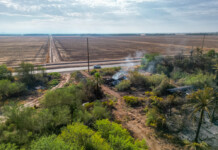
All aboard! Maricopaville, Maricopa’s second location, was definitely all aboard to serve as the junction for two railroads in 1879: the Southern Pacific with its east-west traffic and the Maricopa & Phoenix Railroad that led into central Phoenix.
However, before the tracks could reach Maricopaville from Yuma, the little town had already sprouted up from the desert floor with newspapers reporting that it resembled California’s gold rush towns of earlier years.
The first transcontinental Butterfield Express made a big impact upon the westward expansion in 1858-61 at Maricopa Wells, but, without doubt, the first transcontinental railroad provided an even greater momentum to the westward movement in the late 1800s. The railroad not only facilitated the movement of huge amounts of bulk supplies, gold, people, animals and other goods across the country, but also did it more quickly.
California investors, recognizing lucrative financial opportunities, also got on board a promotional train that led to Maricopaville’s special auction in 1879. They spent thousands of dollars for land with two lots selling for $1000 each. Just a few years earlier, the whole town site of Phoenix was valued at $550 with downtown lots selling at $7-11 each.
Railroad tracks arrived at Maricopaville on April 29, 1879, with newspapers of the day predicting an exciting future for this town and suggesting it might be a good location for the indecisive placement of the state capital. By the middle of May there were more than 500 people living at Maricopaville. It had a post office, express office, several stores, hotels, saloons and many more buildings in the process of being constructed.
One observer recorded, “Maricopa is supplied with excellent water from an artesian well sunk by the company; it was sunk at the depth of 65 feet and is hoisted by an engine running night and day into a tank overhead, holding 50,000 gallons.”
In spite of the busy activity at Maricopaville, the legislature decided to include Tempe on the line, and it was time for the little city in the desert to relocate again…this time three miles east.
However, it took eight years for the Phoenix branch to be completed, and, in the meantime, freight and passengers from all over the northern territory were transported to and from Maricopaville by stagecoaches, wagons and freight teams. Passenger fare was 10 cents a mile, and freight rates were 15 cents a mile per ton. Passengers could travel from Tucson to Yuma (250 miles) for a little less than twenty-three dollars and do the entire trip in one day. This was a good buy, considering that stagecoach travel usually took three days and two nights, and cost about $60.
The Phoenix Herald wrote about the happy atmosphere out in Maricopaville and the latest feature of the town….”a barber shop with an elegant bathroom attached where one could be shaved and cleaned and made happy after experiencing the pleasures of one of those whirlwinds, which everyone is accustomed to see here.” Another improvement was at one of the finer hotels that included an impressive barroom operated by… “a genial son of the Emerald Isle named O’Reilly, who is an expert in mixing fancy drinks, and is always ready to refresh his customers with iced cold drinks.” This particular hotel included 15 neatly furnished rooms designed to make the guests feel at home and keep them happy.
The final chapter in the life of this once bustling little city in the desert closed with these words by the Phoenix Daily Herald newspaper on April 19, 1887: “In a few short weeks, Maricopaville, the once flourishing little railroad terminus and the now busy forwarding point, will succumb to the march of improvement, and its present inhabitants will seek locations elsewhere. Through the long, lonely nights, the coyotes will howl unmolested through the deserted streets, and the owls and the bats will take possession of the abandoned buildings. Here will be a good field for some Arizona Goldsmith to write up another “deserted village” and perhaps a century hence, some scientist turning over the desert sands in search of relics of the past will discover in some empty tomato can or broken beer bottle evidence of an advanced state of civilization at an early period.”
Drawing by Pam Marlar, Cindy Marlar Chance, Michelle Chance
Editor’s note: Maricopa factoids are a regular feature on InMaricopa.com. They are provided by the Maricopa Historical Society, a branch of the Friends of the Maricopa Public Library. Most of the photos and information come from “Reflections of a Desert Town” by author and historical society chairperson Patricia Brock.







![Maricopa’s ‘TikTok Rizz Party,’ explained One of several flyers for a "TikTok rizz party" is taped to a door in the Maricopa Business Center along Honeycutt Road on April 23, 2024. [Monica D. Spencer]](https://www.inmaricopa.com/wp-content/uploads/2024/04/spencer-042324-tiktok-rizz-party-flyer-web-218x150.jpg)



![City gave new manager big low-interest home loan City Manager Ben Bitter speaks during a Chamber of Commerce event at Global Water Resources on April 11, 2024. Bitter discussed the current state of economic development in Maricopa, as well as hinting at lowering property tax rates again. [Monica D. Spencer]](https://www.inmaricopa.com/wp-content/uploads/2024/04/spencer-041124-ben-bitter-chamber-property-taxes-web-218x150.jpg)




